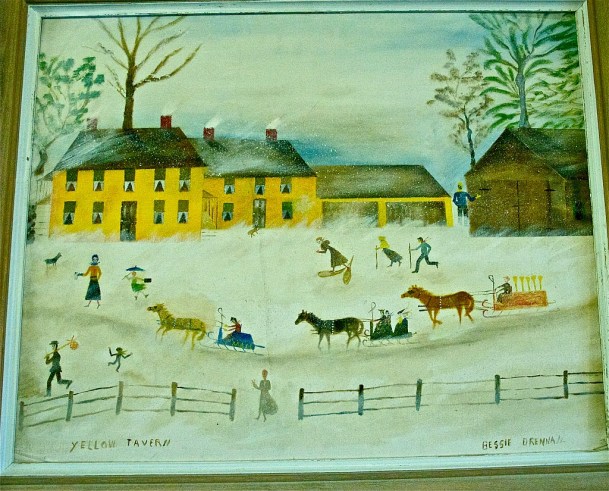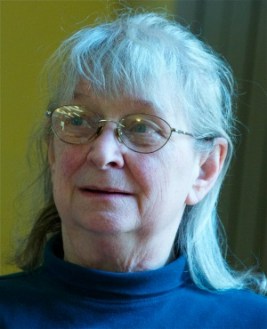
Every autumn for the past 39 years, the Firemen’s Auxiliary of Woodbury, a graying group of community-minded women, has sponsored an art exhibit and craft fair to honor a Vermont original: folk artist Bessie Drennan.
Her works remain obscure decades after her death, but among loyal fans the paintings of Bessie invite comparison to those of another artist of her era: Anna Mary Robertson, better known as Grandma Moses.
On a recent Wednesday afternoon, as happens every year around this time, the cars began arriving at South Woodbury Church on Route 14, and the owners of Drennan art, their treasures tucked under arm, began handing over, for four days, the paintings that grace a wall or two of their homes the rest of the year.
Sometimes as many as two dozen Drennan paintings are exhibited. They hang informally on the back wall of the church’s community hall, a spacious place with tables set for lunch and pie, enough spots for 50 diners at a time.
Around this hall during this event last week, were more tables, these stacked with knitwear, pottery, heirloom potatoes, books by Vermont authors and greeting cards – all kinds of things created in garden, studio, or on computer. They’re for sale, and the whole event pays tribute to the legacy of Bessie Drennan, who strove to create, in her inimitable way, paintings that, with time, are now worth several thousand dollars.

Her art is colorful and loaded with schoolhouses, barns, and horses and buggies and populated with stick-like figures doing anything from ice skating to gathering sap to dancing to fiddle music. She worried at $5 a pop that her paintings were too expensive – and early in her career, they may have been, though her earliest patrons saw the unheralded talent and for a while, at least, bought to encourage as much as collect.
“We have only 10 this year,” confesses Vera Batchelder, 79, who directs this Woodbury art show, and who when young had the good fortune to know Bessie.
“We would have had more paintings this year, but several owners are on vacation, I think in Europe, so while away they didn’t want to worry.”
Not that the Firemen’s Auxiliary doesn’t take precautions. “At our very first event, we had insurance, but it cost more than we took in.”
She points to a folded cot nearby. “We now have someone spend nights here in the church, which is locked, ready to call state police or the neighbors if he hears someone in the night fiddling with the door latch.”
Who was Bessie Drennan? Why the fuss?
“She was a character with a joyful aesthetic and a wonderful sense of movement,” says Olivia Gay, who is from adjoining Calais, and who every year lends her own Drennan painting to the exhibit. Gay’s sister and two aunts have paintings as well thanks to the early support her family, the Kents, gave to the artist.
Gay mentions the late Liza Meyer of Woodbury as another of Bessie’s earliest boosters, along with a literary set from New York, who summered in the area.
David Schutz, Vermont state curator and an art aficionado, describes Bessie’s work as “incredibly charming,” but says it also has a “probing quality that puts her up there with all the important artists of Vermont.
“Drennan goes beyond nostalgia, documenting life in her time, focusing much on the human experience,” says Schutz, whose lives in Kent’s Corner, Calais, a crossroads with an historic church, sawmill, graveyard and (years ago) farm buildings that Bessie celebrated in at least two paintings.
Like Grandma Moses, Drennan didn’t pay much attention to perspective or scale. The two painters shared other attributes: both focused on the rural way of life; both had a nostalgic streak; neither began painting until late in life, and neither had any formal artistic training.

Drennan was less the self-promoter, which may account for some of her art-world obscurity.
Grandma Moses, by contrast, became an early television celebrity by virtue of appearing on Edward R. Murrow’s ‘50s program “See It Now.” Her visage appeared on the covers of Time and Life magazines. Her art was shown in exhibits in New York and Paris, and now much of it has been collected and preserved at the Bennington Museum, near what had been her home in New York state.
Which is not to say Drennan’s works should be considered much less noteworthy. Film director Alfred Hitchcock bought three of Drennan’s paintings when he was in Vermont filming “The Trouble With Harry,” and one of her paintings was sent to President Eisenhower. But Drennan remained a regional artist, in the strictest geographical sense of the phrase.
In 1990, however, the Vermont Folklife Center in Middlebury decided to exhibit her paintings, and Jane C. Beck, who helped put the show together, wrote a booklet about Drennan, “Memories Touched by Fancy,” which goes on sale every year at the Woodbury event.

“I would describe her as a ‘whimsical-memory’ painter,” said Beck in an interview. Beck said she was drawn to Bessie’s art because of her own interest in how (artists) remember things.
“Most people describe memory as unreliable, but it is meaningful,” she said.
But, again, who was Bessie Drennan?
Consider her a Cinderella.
As Beck wrote, she lived for years in the shadow of her prominent sisters, who ran businesses and served in the Legislature.
They were said to carp at Bessie, and never, until late in Bessie’s short career, did they show much appreciation for her art.
Bessie was the one who stayed home to do the chores at the Drennan Hotel and “Yellow Tavern,” rooming houses run by the family in Woodbury that catered to the several hundred men who worked in nearby granite quarries.
In her younger years, Bessie was called upon to paint signs, and she is said to have loved painting flowers on about anything she could find, including a borrowed wooden tray from a neighbor – which mortified one of her sisters when it was time to return the object.
Bessie apparently didn’t think to paint seriously until a day in the mid-1940s when, in her 60s, she attended an adult-education class in art in Montpelier.
In her book, Beck reports that Bessie was aware of Grandma Moses’ success, maybe jealous of it, and one day for whatever reason traveled to Bennington, then took a cab ride to Moses’ home, only to find the place empty. At the cab driver’s insistence, Bessie toured the home of the famous Grandma Moses on her own.
She and Grandma Moses had one final thing in common: both died in 1961.
Vera Batchelder says neither Bessie nor her sisters were particularly engaging, though she liked Bessie, who occasionally invited her in to see her art. Vera described Bessie as an eccentric, whom she remembers going about town wearing a flowing black skirt and black cape that blew in the wind while she blew on a harmonica.

She was feisty. When the state in the early 1950s decided to cut down maple trees and destroy the town green to build the paved highway to Hardwick, Bessie chained herself to a tree in protest.
“They persuaded her to leave, but she was not happy,” says Vera. “What’s sad is that today she would probably get support for what she did.”
Dirk Van Susteren of Calais is a freelance reporter and editor.
